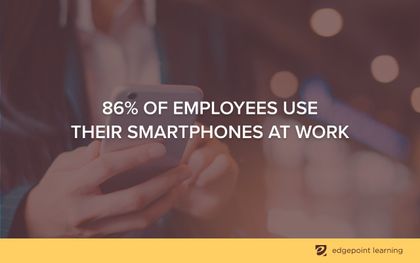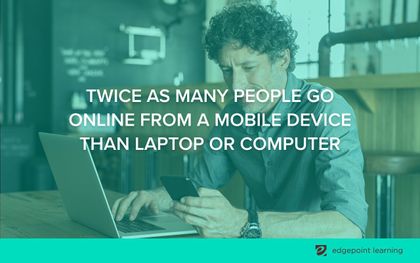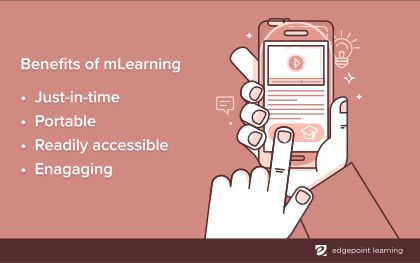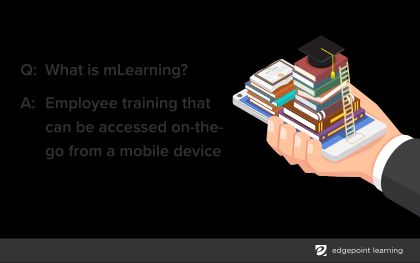What Is mLearning, Or Mobile Learning?
Corey Bleich
🍿 4 min. read
Over six billion people connect to the internet through a mobile device. And, according to UNESCO, twice as many people go online from a mobile device than from a computer or laptop. mLearning, or learning that takes place on mobile devices, can open up huge potentials to train your employees wherever they are. But, what is mLearning?

What is mLearning?
When it comes to your workforce, you want a variety of training solutions that can meet all of their needs. Some training needs to be in-depth, some needs to be in-person, and some needs to be interactive. We talked a bit about the differences between eLearning and instructor-led learning in an earlier post, but one topic we didn't cover in that post was mLearning.
With mLearning, you can capture your employee's most important training in the palm of their hand.
mLearning, or mobile learning as it's also called, isn't just eLearning that's designed for mobile phones and tablets. It's a type of training that uses the advantages of these mobile devices to create better and more focused training materials for your employees.

In 2017, 47% of organizations used mobile devices for training, and that number is only increasing. A full 86% of employees already use their phone at work. The world of mLearning is only going to get bigger. By laying the groundwork now for effective mLearning now, we can guarantee even better opportunities for on-the-job training for our future in-house, on-the-road, and remote employees.
What's the difference between mLearning and eLearning?
To understand the difference between mLearning and eLearning, consider an example. Say, you're creating training materials for new pilots.
You'll need them to review all of the need-to-know information for flying your aircrafts before transferring that knowledge to real-world simulations. But, you'll also need to create a visual checklist for them to go through before beginning each and every flight.
In-depth reviews and simulations may be best handled on computers, but those visual checklists would be so much better if they were somewhere else—right in your pilot's hands before they take off.
Next, think about how you'd train a remote call center staff. They'll need to learn the basic processes for handling each type of customer request, but you also want to create quick reference guides for them as well as short videos when your company launches new products.
Those reference guides and new videos? You guessed it—perfectly matched to mLearning.
mLearning is training that takes place right where your employees need it, when they need it. It's necessarily more focused and concise than the majority of eLearning courses. Whereas most eLearning courses are 20-60 minutes long, mLearning modules are built to take three to ten minutes, max.

What are the major mLearning advantages and disadvantages?
Not every training topic will benefit from mLearning modules, but when used correctly, mLearning provides training that is:
- Just-in-time
- Portable
- Readily-accessible
- Engaging
Mobile learning for workforce training can be a great option for:
- Performance-support tools, such as references, checklists, or calculators
- Pre-workshop or continuing education games, exercises, or simulations
- Bite-sized formal training topics, also called micro-lessons
- Informal, learn-as-you-go topics and videos
- Incorporating new technologies, like augmented reality in corporate training
However, mLearning doesn't take the place of eLearning or in-person training. For effective mLearning, it needs to focus on a specific topic, task, or goal. That means it's not good for larger introductory modules or nuanced topics that require a lot of explanation and practice. Likewise, it's difficult to show complex graphics or flow charts on mobile. mLearning can and should complement these larger topics, but it simply isn't the ideal primary mode of training in these cases.

How do I create an effective mLearning course?
Once you've found a topic that will benefit from mLearning, create a course with mobile in mind. The design itself shouldn't just be an eLearning course made smaller. It must be created for the mobile environment.
That means an mLearning course should be:
- Responsive
- Self-directed
- Easily navigated with larger buttons
- Organized into screens that are focused on one idea each
- Three to ten minutes, max
- Streamlined for faster loading rates
For video content specifically, include easy volume control. If your sales person is on the floor, she won't want a video to start blaring. Incorporate subtitles and make the mute button prominent.
You can create mobile learning courses based on your existing eLearning content, as long as you redesign those courses to actively play into the benefits of mobile. Your courses won't just be smaller—they'll be redesigned for each and every screen.
Mobile learning for your workforce
Your workforce has already gone mobile. Capture key training moments while they're waiting for a meeting to start, when they're standing somewhere in line, or while they're out on the floor talking to customers.
But, before jumping directly into mLearning, make sure it's matched correctly to your training topic. The best mLearning courses are focused, bite-sized micro-lessons or reference materials that your employees can access on the go.
To learn more about the different types of employee training out there, check out our post on the different types of training. Or, if you want to find out how you can create the best training materials for your employees, click the button below to get in touch with the developers at EdgePoint Learning. We'd love to hear about your project.
